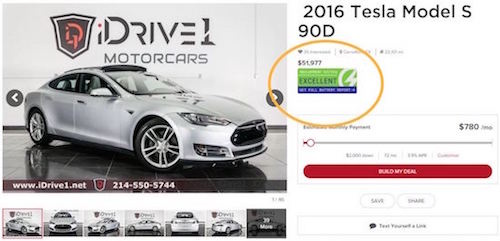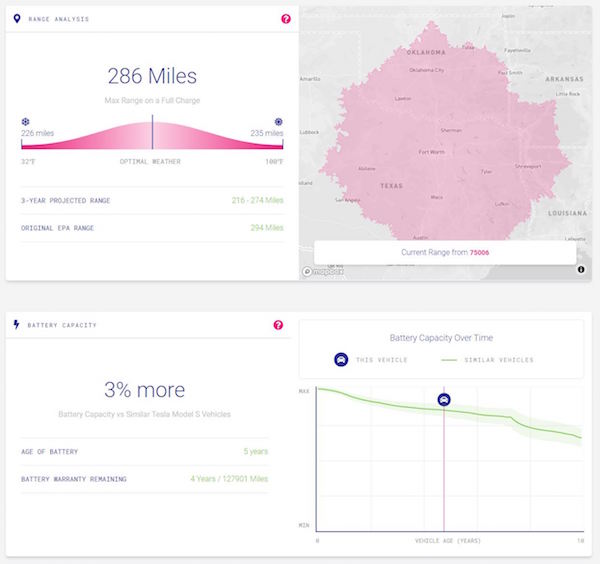What does this mean for the market? Edmunds says: “The savings will vary by model, but on average, used EVs cost 43 to 72 percent less than new ones. If you search the classified listings for EV models that have been out for at least three years, such as the Fiat 500e or the Nissan Leaf, you'll find a number of them for less than $10,000. You would be hard-pressed to find a 3-year-old gas-powered vehicle for the same price. And if you did find one, it is sure to have double or triple the miles on the odometer.”
Alejandra Posada is an Energy Programs Specialist at Peninsula Clean Energy, where she manages EV initiatives that include a used EV rebate program. Posada says that while shorter range vehicles dominated the used market a few years ago, there are now many more long range EVs available. “Vehicles such as a 2017 Chevrolet Bolt or 2019 Nissan Leaf both have over a 200-mile range and can be found for under $16,000.” Here is one I saw listed by Fremont Cadillac as I was writing this. For just $13,420 this Chevrolet Bolt has only 32,000 miles on the odometer, no accidents, a range of 200+ miles, single owner, premium metallic “Arctic Blue” paint, and even a fast charger.

A used EV listing as seen on Edmunds on November 19
Not only is the price low, the fuel (electricity) will cost about one-third as much as gas and there will be minimal maintenance, saving you over $1000 each year. (1) The bottom line is, used EVs are often a really good deal.
I think more people would buy them if they had some guidance on how to buy one, so that is the focus of my post this week.
The Buying Basics
Much about evaluating a used EV is similar to evaluating a used gas-powered car. You want to look at the vehicle history and pay attention to things like accidents and mileage. You want to inspect the car for leaks, poorly-fitting parts, uneven tire wear, and noisy wipers. You want to look at and understand the warranty.
But some things are different. For example, you want to check that the car comes with charging cords, that it charges properly, and that the regenerative braking works well. You want to understand the range of the vehicle and make sure it fits your needs. You want to know what type of charging it supports and make sure you have an outlet. (Keep in mind that most people drive only about 30 miles per day and even a standard outlet can “fill up” 40 miles overnight.)
Repair Smith offers a good overview of all this and more.
Evaluating the Battery
And then there’s the EV battery. The EV battery is a critical component of an EV but, like all batteries, it degrades over time. As the battery degrades, the vehicle’s “range” (the distance it can travel without charging) degrades right along with it. It is extremely expensive to replace an EV battery ($5000 or even $10,000), so you pretty much want to make sure you will be happy with the existing battery, even as it degrades, for as long as you own the car.
The good news is that batteries have much better longevity than you might expect. Fleet management company Geotab reports: “Based on data from over 6,000 electric vehicles, spanning all the major makes and models, batteries are exhibiting high levels of sustained health. If the observed degradation rates are maintained, the vast majority of batteries will outlast the usable life of the vehicle.”

Average EV battery degradation over the first 6.5 years is under 15% (Source: Geotab)
But there’s even more good news than that, including robust battery warranties and an increasing amount of information available about battery health.
Let’s start with the warranty. Edmunds reports that EV batteries are federally required to have an 8-year/80,000 mile warranty. Even better, EVs sold in California are required to have a 10-year/150,000-mile warranty on their batteries. Most of these warranties cover battery degradation beyond a certain point (e.g., 70%). If battery range drops below that, the manufacturer will repair or replace the battery. A warranty like that provides a useful cap on the range loss of your used EV, at least up to 10 years of age.
Next, there is some good information available about how a battery for a specific model is likely to age over time. Take a look at this very educational page from Geotab. They have built an interactive tool that will show how batteries for different models are expected to perform as they age. You can see, for example, how a few different models fare here:

In just two years, a 2018 Mitsubishi Outlander PHEV will have lost almost 20% of its range, while a 2015 Tesla S loses just 10% in five years, and a 2017 Audi loses almost no range in three years.
Posada has another tip. If there’s a specific car you are interested in, she suggests calling the dealer in advance and asking them to fully charge the battery. That way you can check the vehicle range when you test-drive it. That is a great idea, but keep in mind it only gives you a snapshot of the battery and not the overall trajectory. Battery management systems can hide some battery degradation because they have built-in buffers. A 60 kWh battery is often larger under the covers because it incorporates additional cells to accommodate degradation. It is hard to know how much those buffers have been depleted because most EVs hide them.
Evaluating Batteries in Specific Vehicles
This is where a new tool from Seattle-based startup Recurrent is intriguing. Co-founder and CEO Scott Case is intent on making it easier for more people to buy EVs, and sees reducing uncertainty about battery health to be an important part of that. “We need to broaden the appeal of EVs beyond early adopters and wealthy households. The used market makes EVs much more affordable, and we’d like to help everyone feel comfortable buying one.”
Case explains that EV battery longevity is complicated. “The lithium-ion batteries don’t age linearly with mileage. Lots of factors influence longevity, including chemistry and pack layout, software version, operating temperature, storage temperature, use of auxiliary systems, depth of discharge, charging style, driving style, calendar age, terrain. Buyers (and sellers) can’t be expected to do that type of analysis!”
Recurrent has built a data model that takes many of those factors into account in order to assess the battery health of any specific vehicle. They have been gathering real-world data from a “research fleet” of over 2000 vehicles whose owners have agreed to share their data with Recurrent to help refine the model and accelerate EV adoption. “We blend the vehicle data with publicly accessible data like weather or EPA stats to build our model and create our reports.”
Some EV sellers are already providing Recurrent’s used EV battery reports, as you can see below. They are relatively inexpensive for dealers to procure, so if you don’t see this information when you are buying an EV, you can ask them to get you a report.

This car’s battery is in “excellent” shape (Source: iDrive1)
The report itself shows the estimated range of the vehicle today and in three years, how it compares to similar vehicles, and the battery trajectory of similar vehicles.

Sample Recurrent report
EVs these days are able to export a limited amount of information (e.g., the odometer reading, charging status, and remaining range), but information like driving temperature or type of charging may not be available. So I asked Case how Recurrent models battery health when some of this important information is not available. (2) He replied that they are able to infer some information based on where the owner stores their car, or how quickly the car charges. For example, if Recurrent checks a car when it happens to be charging, it may do an extra check a few minutes later to evaluate how quickly it’s charging and deduce the type of charger being used.
Case said they are careful to probe infrequently and collect only information that EV owners are largely comfortable with. “We only collect information 1-3 times per day, and we are very explicit about what we do and don’t collect. To give one example, we don’t collect the location of the vehicle when we ask it for information. The EV’s location would be useful to us for understanding if the battery is charging while hot or cold, but we don’t think most people would be comfortable sharing their vehicle location with us, so we try to approximate the battery temperature in other ways.”
If you are interested in maintaining the health of your own EV battery, Case shares a few basic tips:
- Don’t keep your car at 100% charge all the time if you don’t need that much range on a daily basis. (3)
- Avoid using DC fast charging too often; it adds wear and tear to the battery.
- If you live in an extremely hot climate, it’s better to find a regular parking situation that shades your car or keeps it in a climate moderated parking environment most of the time.
You might also consider joining Recurrent’s research fleet. Recurrent gathers data from thousands of cars today, but is looking to grow its fleet to refine its model and reflect more types of EVs. If you join their research fleet, you will get free battery condition reports each month. (4) It will take one full month of operation before you receive your first report. This is an easy way to help facilitate growth of the used EV market.
Want to Get Started Looking?
Posada has a good deal of experience with the used EV market in the Bay Area, so I asked her for some practical tips on getting started looking for one. For example, where are some good places to look? If you have a particular brand in mind (e.g., Nissan or Chevrolet), she recommends a brand-specific dealership. If you want a wide selection, though, Posada suggests Greenlight Auto in Daly City and Rose Motorcars in Hayward, which focus on selling EVs and hybrids. She also says Carvana has a good selection online.
She emphasized that it’s important to know what you are looking for in terms of range and charging (e.g., do you want fast charge capability), and to familiarize yourself with prices (e.g., via a site like Carvana or the Kelly Blue Book).
The people she has been working with to purchase used EVs have all been happy with their purchases, with two-thirds saying they are “very satisfied”, specifically citing low fuel costs and the environmental benefit.
On Being a Climate Entrepreneur
One of the reasons I write this blog is because I hope to inspire more climate-related innovation in our area. There are so many opportunities. I asked Recurrent’s Case what tips he might have for someone who is interested in making a dent in climate change.
Case replied: “It’s an unimaginably large problem and it can feel daunting for an individual to go “solve” climate change. So I’d say two things:
1. Find a place to start chipping away. There are billions of people on the planet and for those of us that have the privilege and means to work on this problem, I think you just have to get started and not worry about having a complete picture of how the whole thing gets ‘solved’.
2. If you’re going to do it as an entrepreneur, make sure there is an actual market and willingness for someone to pay for your ‘solution’. Otherwise, maybe there’s another way to work on it rather than a startup.”
Relatively few of us are entrepreneurs and innovators, but most of us are car owners. A used EV is an affordable and smart purchase. I wish I’d known more about them when I bought an EV a few years ago. I’d love to hear your experiences with EV shopping, and hope some of you will take advantage of end-of-year sales!
Notes and References
1. Here is how you might look at the cost of driving 100 miles. Suppose you have a pretty typical gas car, getting 25 miles per gallon. It takes 4 gallons to drive 100 miles. If you pay $3.50/gallon, then it costs $14 (not including maintenance) to drive 100 miles. What about for an EV? Suppose you have a pretty typical electric car in temperate weather, getting 4 miles per kWh. It takes 25 kWh to drive 100 miles. If your electricity costs $0.19 per kWh, then it costs $4.75 to drive 100 miles. That is one-third the rate of the gas car. You can plug in your own figures to determine your savings.
2. High temperatures and frequent fast-charging are known to impact battery performance.
3. It may be hard to know when your battery is at full charge because of the buffers that battery manufacturers add to protect their batteries and ensure long lifetimes. That is why many EV manuals say that it is fine to “fill up” the battery, because the built-in buffers will protect it. If you don’t need the full range of the battery, it can’t hurt to add an extra buffer. I fill mine up to 90% unless I’m going on a long trip and need the full range. (The Chevrolet Bolt has a setting that allows you to specify how full you want the battery to charge.)
4. Case says that the offer of free monthly reports won’t last, so if you are interested, sign up sooner rather than later. You can un-signup at any time.
Current Climate Data (October 2020)
Global impacts, US impacts, CO2 metric, Climate dashboard (updated annually)
This illustrates why we should all switch to an EV soon. Used EVs are a good way to get started.

Comment Guidelines
I hope that your contributions will be an important part of this blog. To keep the discussion productive, please adhere to these guidelines or your comment may be moderated:
- Avoid disrespectful, disparaging, snide, angry, or ad hominem comments.
- Stay fact-based and refer to reputable sources.
- Stay on topic.
- In general, maintain this as a welcoming space for all readers.



